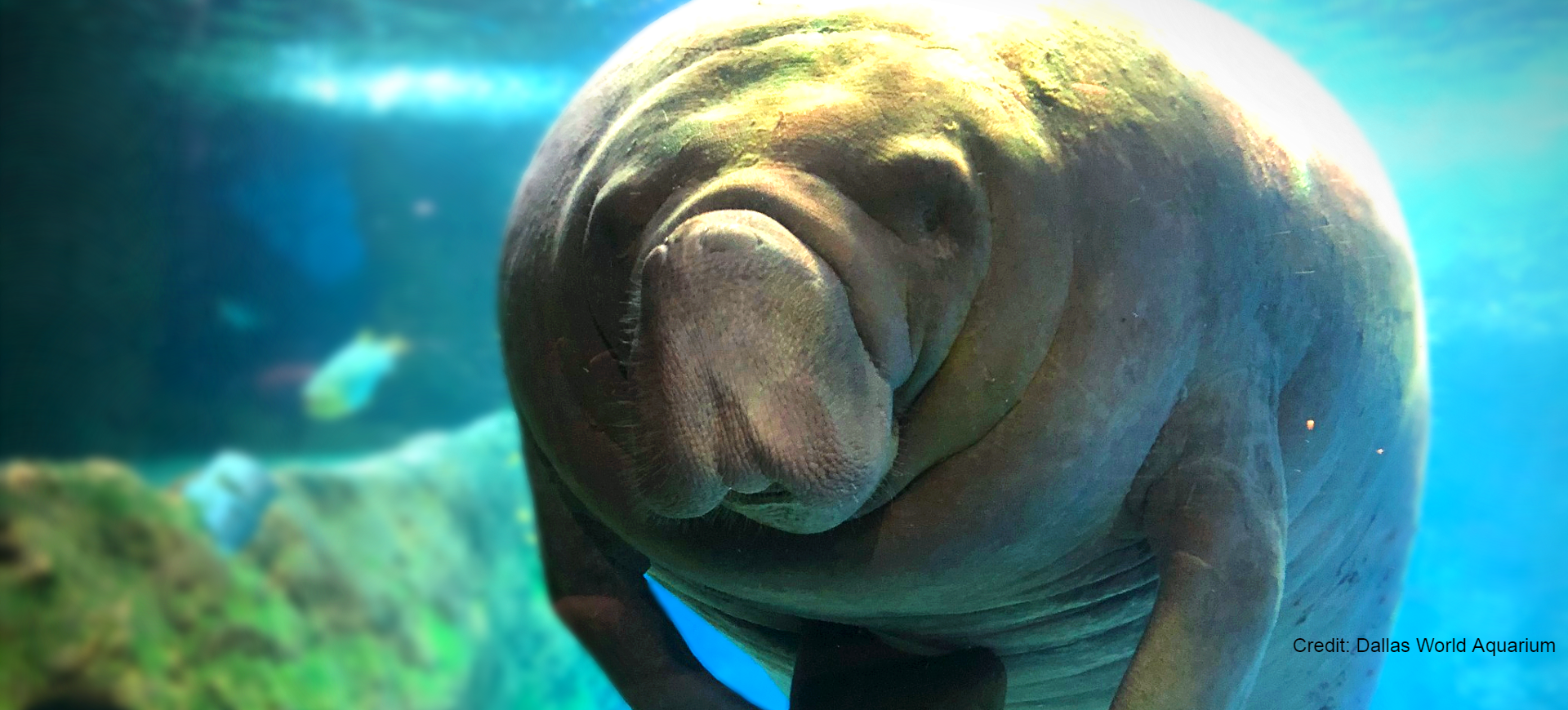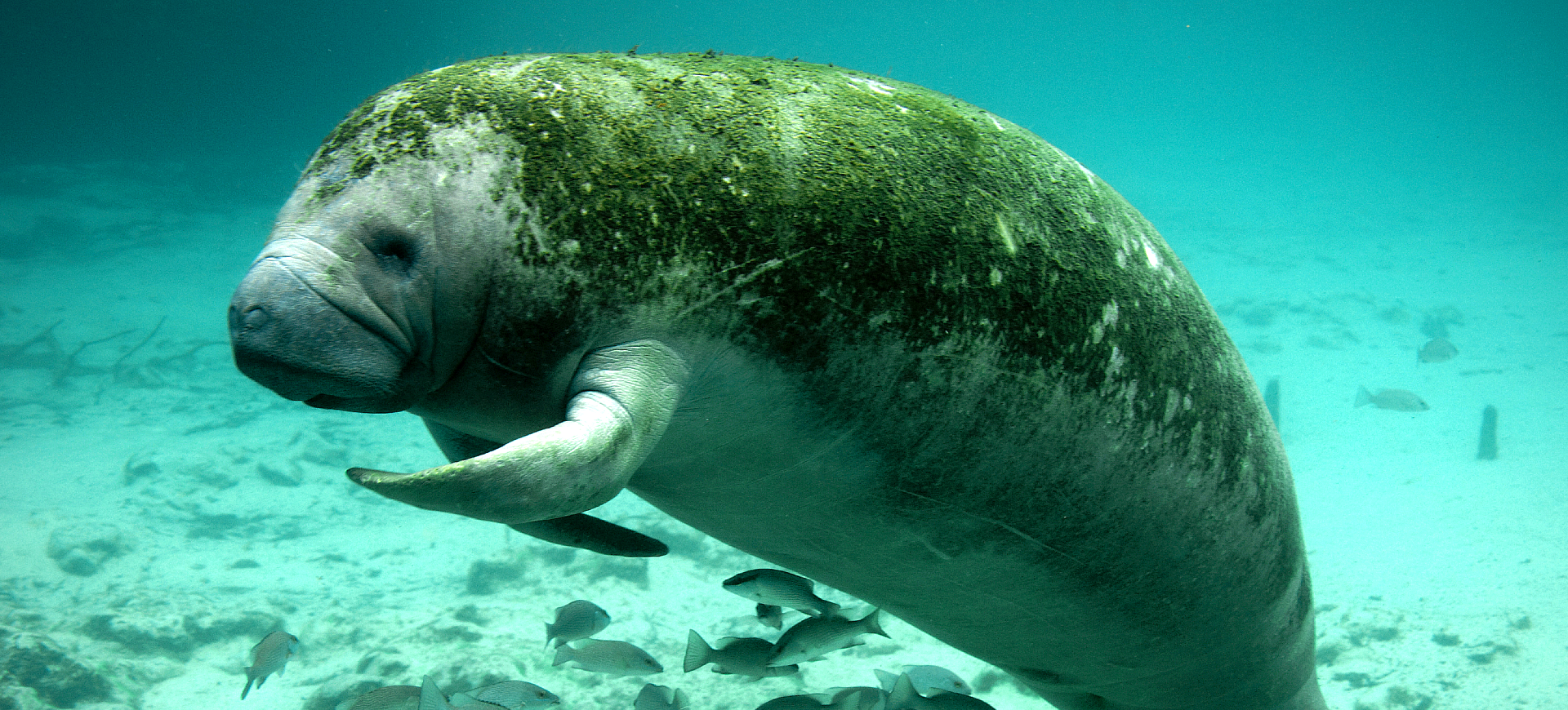Overview
The Florida Manatee, a subspecies of the West Indian Manatee (Trichechus manatus latirostris), is a gentle and slow-moving aquatic mammal residing primarily in the freshwater, brackish, and marine environments of the southeastern United States. Distinguished by their large, elongated bodies covered in grayish-brown skin, these creatures are often called “sea cows” due to their herbivorous diet and peaceful demeanor. Florida Manatees are characterized by their paddle-shaped tails and two front flippers, which aid navigation and feeding.
These marine mammals are well adapted to life in warm waters. They seek out heated refuges such as natural springs or power plant discharges during colder months to maintain their body temperature. Despite their bulky appearance, Florida Manatees are capable swimmers and can execute graceful maneuvers in the water. They play a crucial role in their ecosystem, contributing to the health of aquatic vegetation and serving as indicators of environmental health.
Conservation efforts for the Florida Manatee have been significant, as they face numerous threats from habitat loss, water pollution, and collisions with watercraft. Through protective legislation, habitat restoration, and public education, strides have been made to safeguard these iconic animals, improving some population metrics. However, continued vigilance and conservation actions are necessary to ensure the survival and prosperity of the Florida Manatee.
Taxonomy
Kingdom
Phylum
Class
Order
Family
Genus
Species
Sub Species
Type
Physical Description:
Florida Manatees are notable for their stout, streamlined bodies, which can reach lengths of up to 13 feet and weigh as much as 1,200 pounds, although some individuals may grow larger. Their skin is thick and wrinkled, often hosting a variety of algae, which can give them a greenish tint. The face of a Florida Manatee features small, widely spaced eyes, a large snout, and vibrissae (whiskers) that enhance their tactile sense.
Their front flippers are equipped with nails, a characteristic that differentiates them from other manatee species and is used for steering, crawling along the bottom, and manipulating food. The tail is broad and paddle-shaped, providing powerful propulsion through the water. Despite their considerable mass, Florida Manatees are surprisingly agile in their aquatic environment, capable of precise movements and turns.

Lifespan: Wild: ~40 Years || Captivity: ~60 Years

Weight: Male: 1,200-3,000 lbs (540-1,360 kg) || Female: 800-1,200 lbs (360-540 kg)

Length: Male: 120-156 inches (304-396 cm) || Female: 108-120 inches (274-304 cm)

Top Speed: 20 mph (32 km/h)
Characteristic:
Native Habitat:
The native habitat of the Florida Manatee encompasses the warm coastal waters, rivers, and estuaries of the southeastern United States, primarily within the state of Florida. They are adapted to fresh and saltwater environments, often migrating between the two in search of food, warmth, and freshwater sources for drinking. Manatees congregate in natural warm-water springs and areas affected by warm water discharges from power plants to avoid cold stress during the winter months.
Their habitats’ shallow, calm waters provide ideal conditions for feeding and breeding. Protection of these areas is crucial for the conservation of the Florida Manatee, as they are sensitive to changes in water temperature, quality, and availability of vegetation.
Biomes:
WWF Biomes:
Biogeographical Realms:
Continents:
Countries:
Diet:
Diet & Feeding Habits:
Florida Manatees are herbivores, feeding on various aquatic plants in their freshwater and marine habitats. They consume submerged and floating vegetation, including seagrasses, water hyacinths, and other plant species. These manatees need to eat approximately 10-15% of their body weight in vegetation daily to sustain their large size, which involves grazing for several hours daily.
Their feeding habits play a significant role in maintaining healthy aquatic ecosystems, as they help control vegetation growth and promote water flow in densely vegetated areas. Florida Manatees use their flexible, prehensile lips to gather and manipulate food, demonstrating a preference for certain plant species depending on availability and nutritional content.
Mating Behavior:
Mating Description:
Florida Manatees exhibit a polygynous mating system, where males compete to mate with receptive females. Mating herds, consisting of one female and several males, are common during the breeding season. These herds engage in complex social and physical interactions lasting for several weeks.
Females give birth to a single calf after a gestation period of about 12 to 14 months, with births occurring throughout the year but peaking in the spring and summer months. The calf is born underwater and must surface for its first breath shortly after birth. Calves remain dependent on their mothers for up to two years, during which they learn essential survival skills, including migration routes and feeding habits. The slow reproductive rate of manatees is a challenge for population recovery efforts.
Reproduction Season:
Birth Type:
Pregnancy Duration:
Female Name:
Male Name:
Baby Name:
Social Structure Description:
Florida Manatees are generally solitary but are known to form groups, especially in warm-water refuges during the winter or in areas with abundant food sources. Their social interactions increase during the mating season, and strong mother-calf bonds are observed, with calves relying on their mothers for guidance and protection. Understanding the social behavior of Florida Manatees is important for their conservation, influencing management decisions regarding their protection and habitat preservation.
Manatees communicate through vocalizations that serve various purposes, including coordination among individuals in mating herds and mother-calf interactions. These vocal communications play a crucial role in the social lives of manatees, facilitating interactions within their aquatic environment.
Groups:
Conservation Status:
Population Trend:
The Florida Manatee population has been under close observation and protection due to their vulnerability. Conservation efforts, including habitat protection, regulation of boat speeds, and public education campaigns, have contributed to a gradual increase in population numbers. However, manatees face significant threats from habitat loss, water pollution, and boat strikes, which necessitate ongoing conservation actions.
The establishment of manatee protection zones and measures to reduce watercraft-related mortality have been key to the subspecies’ recovery. Continued research and monitoring are essential for understanding population dynamics and the effectiveness of conservation strategies, ensuring the Florida Manatee remains a vital part of its ecosystem.
Population Threats:
The primary threats to the Florida Manatee include collisions with boats and watercraft, which can result in serious injuries or fatalities. Additional concerns include habitat loss due to waterfront development, pollution affecting water quality and food sources, and entanglement in fishing gear. Cold stress during winter, when manatees seek warm-water refuges, remains a significant risk, particularly as natural warm-water sites become scarce.
Red tide and other harmful algal blooms can devastate manatee populations, leading to illness and mortality. Addressing these threats requires a multifaceted approach, including habitat conservation, regulation enforcement, and public awareness efforts.
Conservation Efforts:
Conservation initiatives for the Florida Manatee have included the designation of protected areas, implementation of boat speed zones to reduce collision risks, and public education programs aimed at promoting manatee awareness and safety. Rehabilitation programs for injured manatees play a critical role in conservation, providing care and facilitating the return of healthy individuals to their natural habitats.
Research and monitoring efforts continue to be essential for tracking population health and understanding the impacts of environmental changes. Collaboration among government agencies, conservation organizations, and local communities is vital for successfully conserving the Florida Manatee, ensuring this iconic species thrives for future generations.
Additional Resources:
Fun Facts
- Florida Manatees have no natural predators and rely on their size as a defense mechanism.
- They can consume up to 10% of their body weight in vegetation daily.
- Manatees must surface every 3-5 minutes to breathe but can hold their breath for up to 20 minutes while resting.
- They have a unique system of constantly replacing worn teeth with new ones from the back of their jaw.
- Manatees can perform agile maneuvers despite their size, including tight turns and rolling over underwater.
- Their closest living relatives are elephants, with which they share a common ancestor.
- Manatees have been known to interact with divers and swimmers, showing curiosity and sometimes seeking physical contact.
- The regulatory efforts to protect manatees have led to the creation of manatee viewing areas that attract tourists and wildlife enthusiasts.
- They play a crucial role in controlling aquatic vegetation, contributing to the health of their ecosystems.
- Florida Manatees are known for their gentle nature and have become a symbol for conservation efforts in aquatic environments.









